Performance
The Dell Inspiron M101z is the first AMD Nile-powered notebook to enter the HEXUS labs.
We're eager to see how it fares so we'll be putting it up against two competing platforms; Intel's Atom and CULV, both of which are represented in our benchmarks by the MSI Wind U160 and Acer Timeline 3810T, respectively.
We'd expect the £500 AMD-based system to run circles around the £330 MSI Wind, but how will it compare to the £500 Acer Timeline?
Before we find out, here's a look at the key specifications of our comparison notebooks, as well as a brief rundown of the benchmarks we use.
| Comparison systems | |||
|---|---|---|---|
| Laptop | Dell Inspiron M101z | MSI Wind U160 | Acer Timeline 3810T |
| Processor | AMD Athlon II Neo K325 (1.30GHz, 2MB L2 cache, dual-core) | Intel Atom N450 (1.66GHz, 512KB L2 cache, single-core) | Intel Core 2 Duo SU9400 (1.40GHz, 3MB L2 cache, dual-core) |
| Memory | 4GB DDR3 800MHz | 1GB DDR2 667MHz | 2GB DDR3 800MHz |
| Graphics | AMD ATI Mobility Radeon HD 4225 | Intel GMA 3150 | Intel GMA 4500MHD |
| Graphics driver | AMD ATI Catalyst 10.7 | Intel 8.14.10.2117 | Intel 7.15.10.1666 |
| Display | 11.6in - 1,366x768 | 10.0in - 1,024x600 | 13.3in - 1,366x768 |
| Battery | 6 cell, 56Whr | 6 cell, 65Whr | 6 cell, 56Whr |
| Weight | 1,572g (including battery) | 1,237g (including battery) | 1,645g (including battery) |
| Wireless | Broadcom WLAN Half-Mini Card (802.11bgn) and Bluetooth 2.1 | Ralink 1T1R (802.11bgn) | Intel WiFi 5100 (802.11bgn) and Bluetooth 2.0 |
| Disk drive | Seagate Momentus 320GB, 7,200RPM, 16MB cache | Seagate Momentus 250GB, 5,400RPM, 8MB cache | Hitachi 500GB, 5,400RPM, 8MB cache |
| Optical drive | None | None | None |
| Operating System | Microsoft Windows 7 Home premium, 64-bit | Microsoft Windows 7 Starter, 32-bit | Microsoft Windows 7 Home Premium, 32-bit |
| Benchmarks | |||
| Geekbench 2.1.6 | A cross-platform benchmark used to measure memory and processor performance. Run using high-performance mode. | ||
| Cinebench 11.5 | Using Cinebench's multi-CPU render, this cross-platform benchmark stresses as many cores as possible. Run using high-performance mode. | ||
| 3DMark06 | A PC benchmark used to test the DirectX 9 performance of a system's graphics card. Run using high-performance mode. | ||
| Battery test | In order to measure battery life, we run the notebook on balanced power settings and loop a 720p movie trailer, measuring the time taken to hibernate. | ||
| Power consumption | Using balanced power settings, we record mains power draw whilst playing back a 720p movie trailer. | ||
CPU and GPU performance
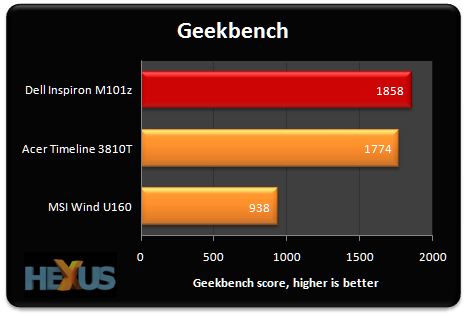
With its large 4GB serving of DDR3 memory, Geekbench puts the Dell Inspiron M101z out ahead of the Intel competitors.
There's a sizeable gap between the M101z and the Atom-powered Wind U160, but Acer's CULV-powered machine is right on AMD's tale.
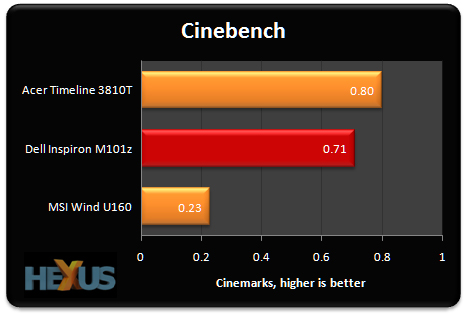
Cinebench shows off the performance of the respective notebook CPUs.
The Intel Atom N450 quite simply isn't all that capable, and whilst the dual-core AMD Athlon II Neo K325 is an improvement, it still falls short of the ageing ultra-low-voltage Intel Core 2 Duo SU9400.
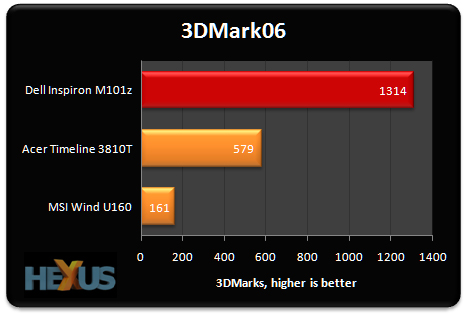
But it's in the graphics department that AMD's Nile platform truly shines.
Eclipsing Intel's GMA offerings, AMD's integrated ATI Mobility Radeon HD 4225 GPU clearly offers more graphical grunt - but it will only get you so far.
3D Gaming at anything near the system's native resolution remains a no-go, but playing back hardware-accelerated video is quick and seamless.
Battery life and power consumption
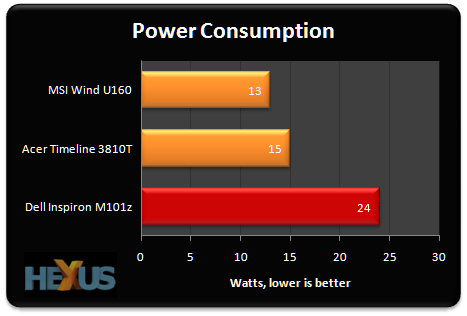
Perhaps more importantly, the AMD-powered system is the most power hungry of our comparisons; eating up 24 Watts of juice whilst playing back a 720p movie.
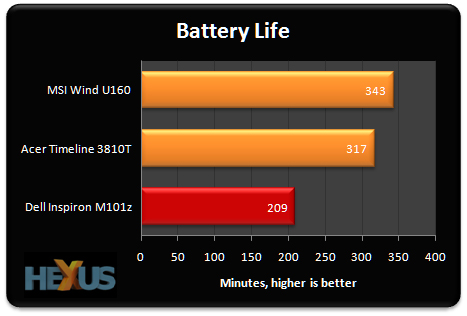
As expected, that higher-than-average power draw has its consequences.
Looping our 720p video, we found the Inspiron M101z managed to keep going for just under three and a half hours before succumbing to hibernation.
Not an entirely bad outcome, but clearly inferior to the competition. Acer's Intel CULV-based system lasts over 60 per cent longer when using a similarly-spec'd six-cell battery.









